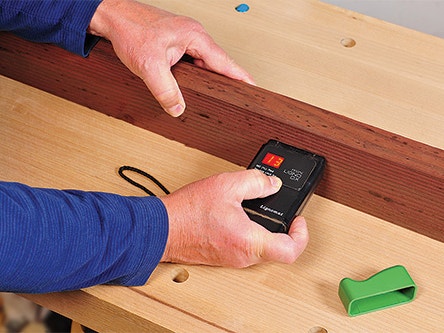The Basics of Wood and Water
There’s just no way around it: Moisture in the air causes wood to change in size and often in shape.
Consider it an invitation to read up on the physical realities that make changes wood moisture content a basic aspect of the craft, and to equip yourself with one of the most fundamental of all woodworking tools: a moisture meter. Understanding the underlying principles of the wood/water relationship is the first step. There are numerous books explaining the effects of moisture on wood, drying techniques, and how to ready your projects for ever-changing relative humidity. R. Bruce Hoadley's Understanding Wood is held by many to be the best, and covers moisture content thoroughly, along with just everything else you'd ever need to know about the physical properties of wood. We're sure that all serious woodworkers have a copy of it - or a similar book - in their library, and are experts on the effects of wood moisture content. For everyone else, here are a few of the basics.
For everyone else, here are a few of the basics. Wood moisture content is the ratio, expressed as a percentage, of the weight of its water content to the weight of the wood fibers if they were completely dry. For example, if a piece of lumber weighs 10 pounds, and would theoretically weigh 5 pounds if it were absolutely devoid of water, then it is said to have a moisture content of 100 percent. Usable lumber is produced by reducing the moisture content of green wood (sometimes well over 200 percent) to 12 - 18 percent by air drying, or to 6 - 10 percent by kiln drying. The purpose of doing this, of course, is to prepare the wood for the average moisture content of the air in which ultimately, it will take up residence as part of a chair, table, cabinet or what have you. If a piece of wood is in perfect equilibrium with relative humidity of the air surrounding it, it will neither absorb moisture from the air, nor will the air absorb moisture from it. This state of perfect balance is called "equilibrium moisture content" (EMC).
For the woodworker, equilibrium is a good thing, because it means that the wood will stay (for practical purposes) the same size and shape. In reality, of course, there are changes in humidity, and they can be dramatic, especially in climates where heating greatly reduces the relative humidity indoors during the winter months. Equilibrium moisture content is really an ideal. The best you can do is to accept the fact that wood is just going to move along with changes in the weather, and to take that into account in the way your design and build your projects. And you'll have a lot easier time of it if you know something about the moisture content of the wood you’re using, and make a point of starting off with lumber that’s suitably dried. To begin doing, that you'll need a "moisture meter". There are two basic types of moisture meter: Pin-style moisture meters and the "pinless" variety.
A pin-style meter has two probes, or "pins" that are pressed into the wood; the meter measures moisture content by measuring the resistance of the wood as the conductor of an electrical current from one pin to the other. A pinless moisture meter uses radio waves to create an electro-magnetic field penetrating the wood. The meter measures the reaction of the radio waves to the moisture in the wood. Which one should you choose? A pinless moisture meter and the pin-type moisture meter both give accurate readings of moisture content, and plenty of moisture reading range and sensitivity for most woodworking applications. But there are a couple of minor differences to consider:a pinless meter penetrates to a depth of 1/2 inch, and will give you a good idea of what is going on inside the wood, and not just near the surface. And of course, the pinless variety won't leave two pinholes in your stock.
A typical piness moisture meter penetrates to a depth of 1/2 inch, and will give you a good idea of what is going on inside the wood, and not just near the surface. And of course, the pinless variety won't leave two pinholes in your stock. The pinless meter’s range of 4 – 22 percent is fairly narrow as moisture meters go, but you wouldn't consider using anything outside of that range for most woodworking projects, anyway.
A pin-style moisture meter has one obvious advantage: It's less expensive. (For that matter, if you're really on a budget, there's more basic pin-type units for even less.) The pin-type meter offers considerably more range than a pinless meter, with a range of 6 – 55 percent. And while the upper end of the scale won't help you much with the typical woodworking project, it can come in handy for checking construction lumber or green turning stock. It also has two species correction settings and an extra set of longer pins for deeper readings.
Adding either one to your tool collection, along with a reliable wood book, is an excellent way to begin side-stepping the frustrations that go along with ignoring moisture content: miter joints that pull apart, unexpected cupping or twisting, and a host of other surprise difficulties that can ruin a woodworker's day.
Keep the inspiration coming!
Subscribe to our newsletter for more woodworking tips and tricks






